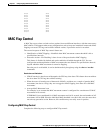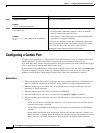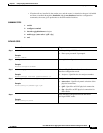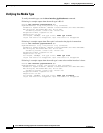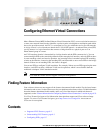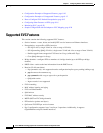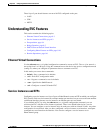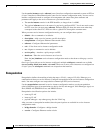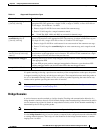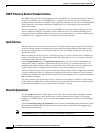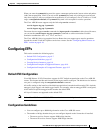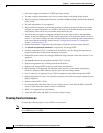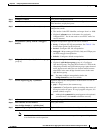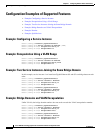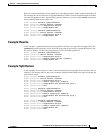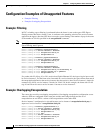
8-5
Cisco ASR 901 Series Aggregation Services Router Software Configuration Guide
OL-23826-09
Chapter 8 Configuring Ethernet Virtual Connections
Understanding EVC Features
If a packet entering or leaving a port does not match any of the encapsulations on that port, the packet
is dropped, resulting in filtering on both ingress and egress. The encapsulation must match the packet on
the wire to determine filtering criteria. On the wire refers to packets ingressing the router before any
rewrites and to packets egressing the router after all rewrites.
Note The router does not allow overlapping encapsulation configurations. See the “Configuration Examples
of Unsupported Features” section on page 8-12.
Bridge Domains
A service instance must be attached to a bridge domain. Flooding and communication behavior of a
bridge domain is similar to that of a VLAN domain. Bridge-domain membership is determined by which
service instances have joined it (based on encapsulation criteria), while VLAN domain membership is
determined by the VLAN tag in the packet.
Note You must configure encapsulation before you can configure the bridge domain.
Use the bridge-domain bridge-id service-instance command in the configuration mode to bind the EFP
to a bridge domain instance. The bridge-id is the identifier for the bridge domain instance, a number
ranging from 1 to 4094.
Table 8-1 Supported Encapsulation Types
Command Description
encapsulation dot1q vlan-id
[,vlan-id[-vlan-id]]
Defines the matching criteria to be used to map 802.1Q frames ingress on an interface to the
appropriate EFP. The options are a single VLAN, a range of VLANs, or lists of VLANs or
VLAN ranges. VLAN IDs are 1 to 4094.
• Enter a single VLAN ID for an exact match of the outermost tag.
• Enter a VLAN range for a ranged outermost match.
Note VLAN IDs 4093, 4094, and 4095 are reserved for internal usage.
encapsulation dot1q vlan-id
second-dot1q vlan-id
[,vlan-id[-vlan-id]]
Double-tagged 802.1Q encapsulation. Matching criteria to be used to map QinQ frames
ingress on an interface to the appropriate EFP. The outer tag is unique and the inner tag can
be a single VLAN, a range of VLANs or lists of VLANs or VLAN ranges.
• Enter a single VLAN ID in each instance for an exact match of the outermost two tags.
• Enter a VLAN range for second-dot1q for an exact outermost tag and a ranged second
tag.
encapsulation dot1ad
vlan-id[,vlan-id[-vlain-id]]
[native]
Defines the matching criteria to be used in order to map single-tagged 802.1ad frames ingress
on an interface to the appropriate service instance. The criteria for this command are: single
VLAN, range of VLANs and lists of the previous two.
encapsulation untagged Matching criteria to be used to map untagged (native) Ethernet frames entering an interface
to the appropriate EFP.
Only one EFP per port can have untagged encapsulation. However, a port that hosts EFP
matching untagged traffic can also host other EFPs that match tagged frames.
encapsulation default Configures default encapsulation.



